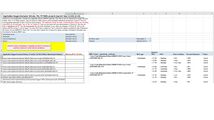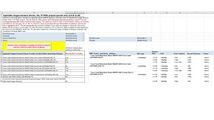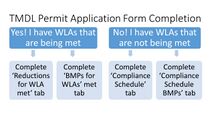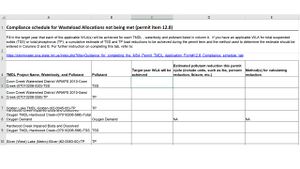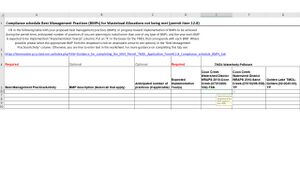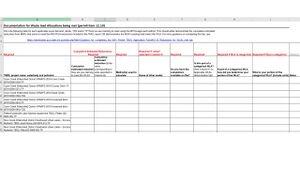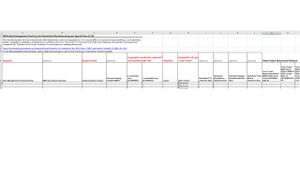
Guidance for completing the MS4 Permit TMDL Application Form
This page is in development
This page provides guidance for completing the Municipal Separate Storm Sewer System Permit TMDL Application Form. Completing and submitting this form is a requirement for permittees who have Total Maximum Daily Loads (TMDLs) Wasteload Allocations (WLAs) for total phosphorus (TP), total suspended solids (TSS), oxygen demand, or nitrate.
Description of the form
Each MS4 Permit TMDL Application Form is a custom created workbook for each permittee with United States Environmental Protection Agency (USEPA) approved Total Maximum Daily Load (TMDL) wasteload allocations (WLAs). The workbook consists of eight tabs. Three tabs are informational- for the permittee to reference in order to complete the MS4 Part 2 Permit Application, or to reference while completing the other five tabs in this workbook.
Information tab
General instructions on how to complete the form, and reference links.
Bacteria Chloride Temp tab
Informational tab- lists any applicable WLAs for bacteria, chloride or temperature TMDL projects (USEPA approved, more than a zero % reduction). Use the information in this tab to answer questions 141, 146 and 151 in the MS4 Part 2 Permit Application. If there is not a project listed for any certain pollutant, you would check the 'No' box for the corresponding question(s) in the MS4 Part 2 Permit Application.
Applicable WLAs determination tab
This tab includes two separate lists. The list in Column A contains any applicable WLAs (USEPA approved, more than a zero % reduction) for oxygen demand, nitrate, TSS, or TP TMDL projects. They are listed by TMDL project name-waterbody-(waterbody id)-pollutant. Column F lists the corresponding applicable numeric WLAs for those projects. If Columns A and F do not show any projects, you do not have any applicable WLAs, and you do not need to complete the TMDL Application. The list of permittees who have no applicable WLAs are located here. Otherwise, the applicant needs to make a determination if they are meeting each WLA or not and type 'Yes' or 'No' in Column B. Once the determination is made, there is a macro that needs to run, and this will autopopulate the rest of the workbook.
- Applicable WLAs Determination tab screenshots and Decision Tree. Click on an image for enlarged view.
In order to complete that determination, the following will be needed:
- An inventory of structural stormwater BMPs and non-structural BMPs (e.g. establish ordinance, education and outreach, illicit discharge elimination, etc.) within the watershed boundary to the impaired water and that are being applied toward meeting the WLA(s). To determine watershed boundaries see the specific TMDL report or retrieve shapefiles from the MPCA.
- An estimate of annual cumulative pollutant load reductions (pounds or percent) for implemented BMPs.
- An estimate of pollutant loading rates (lb/ac/yr) to the impaired water.
Compliance schedule tab
This tab needs to be completed for each WLA that is not being met. Permittees will fill in the target year that each of the applicable WLA(s) will be achieved for each TMDL- waterbody- pollutant project listed in column A. If there is an applicable WLA for total suspended solids (TSS) or total phosphorus (TP), a cumulative estimate of TSS and TP load reductions to be achieved during the permit term and the method used to determine the estimate should be entered in Columns D and E.
Compliance schedule BMPs tab
This tab will be filled in with proposed best management practices (BMPs) or progress toward implementation of BMPs to be achieved during the permit term, anticipated number of practices (if the permittee is planning to install more than one of any type of BMP), and the year each BMP is expected to be implemented ("Implementation Year(s)" column). Put an "X" in the boxes for the TMDL that corresponds with each BMP.
Reductions for WLAs met tab
This tab requires the permittee to submit required information for each applicable oxygen demand, nitrate, TSS and/or TP WLA they are claiming to meet. This substantiation needs to be completed using an MPCA-approved method. This should either demonstrate the cumulative estimated reductions from BMPs that serve to meet the MS4 WLA reductions included in the TMDL report OR demonstrates the MS4's existing load meets the WLA.
BMPs for WLAs met tab
This tab requires the permittee to submit required information for each applicable oxygen demand, nitrate, TSS and/or TP WLA they are claiming to meet with a list of all stormwater BMPs implemented to achieve the applicable WLA. For structural BMPs, it is required to include the BMP type, year implemented, location in geographic coordinates (x coordinate and y coordinate), and owner.
Master list tab
This table is for reference only and shows ALL waste load allocations assigned to an MS4 and all flow zones, whether they need to be reported on in the TMDL application or not. This is a filterable list, and can be changed to show other permittees, projects, etc.
FAQ
Please submit questions to Anna Bosch at the MPCA.
Examples
- Case study for using P8 to meet TMDL permit requirements
- Case study for using WINSLAMM to meet TMDL permit requirements
- Case study for using the MIDS calculator to meet TMDL permit requirements
- Case studies for monitoring to meet TMDL permit requirements
Related pages and useful links
- Summary of TMDL requirements in stormwater permits
- Overview of models used to meet MS4 TMDL permit requirements
- Recommendations and guidance for utilizing P8 to meet TMDL permit requirements
- Recommendations and guidance for utilizing WINSLAMM to meet TMDL permit requirements
- Recommendations and guidance for utilizing the MIDS calculator to meet TMDL permit requirements
- MIDS calculator
- Recommendations and guidance for utilizing the MPCA Simple Estimator to meet TMDL permit requirements
- [MPCA Simple Estimator]
- Recommendations and guidance for utilizing monitoring to meet TMDL permit requirements

